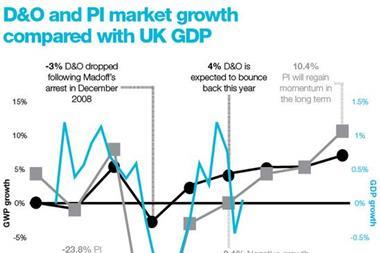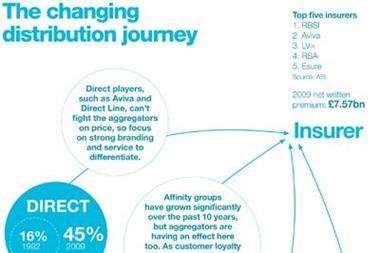What happened, why, and what's next in the UK motor market
What happened: Bodily injury rise hits results
Major insurers saw profits plummet
? The increase in bodily injury claims hit several major insurers hard in the summer of 2010, revealing reserving inadequacies.
? The eye-watering impact of bodily injury claims on the UK’s largest motor insurer became clear in August 2010, when RBS Insurance reported a second-quarter operating loss of £203m. Combined with its first-quarter loss of £50m, the insurer had shed £253m in six months – a figure greater than its £217m profit for the same period the previous year. Its Q2 combined operating ratio was 128.7%.
? In July 2010, IAG UK reported profits down by 50%, as it was forced to pump £206m into its reserves. Soon after, the FSA launched a probe into the company and its motor division, Equity Red Star.
? Fortis (now Ageas), another major motor insurer, saw its profit before tax for the first half of 2010 slump 68% to £8.4m, from £26m in the same period last year. Its combined ratio increased 2.1 percentage points to 106.5% from 104.4%.
Claims ballooned
? Tradex was hit with a £13.75m motor payout to a professional cyclist left permanently disabled in a road crash. The record payout was ordered by Guernsey’s Court of Appeal. Manny Helmot, who represented Guernsey in the 1998 Commonwealth Games, spent 36 weeks in hospital and was left partially blind, with no use of his right arm and with brain injuries after a training ride crash in 1998. Helmot now needs 24-hour care and is unable to work, drive or ride a bike.
? In April 2010, the Ministry of Justice introduced claims reforms, with a new fast track for claims below £10,000. But the introduction of the reforms was dogged by technological failures, and their impact has yet to be fully realised.
? In September 2010, a moneysupermarket.com report suggested that one out of every 20 motorists aged under 35 has ‘staged’ an accident in order to make a fraudulent car insurance claim.
What it meant
Companies had nowhere to hide
? The bodily injury storm had been gathering pace since 2009, but in the summer of 2010, its full extent became only too clear. The biggest shock was the scale of the losses at RBS Insurance – the huge write-downs prompted many observers to question the insurer’s approach to reserving, particularly in the light of its recent and abortive sales process.
? With the FSA looking into reserving at Equity Red Star as well, it was clear to the market that they had to face up to bodily injury, and reserve and price accordingly.
? The explosion in bodily injury claims sorted the wheat from the chaff in the market, with weaker players dropping out, and any poor pricing or reserving made clear for all to see. It also highlighted the (very few) success stories that have apparently bucked the trend – such as Admiral.
What happened: Capacity left the market
Motor divisions were scaled back or shed …
? HSBC put its motor insurer arm into run-off in September 2009. By the beginning of 2010, it had emerged through an Insurance Times investigation that a total of £213.5m had been pumped into the reserves prior to run-off, following a loss of £178m in 2009. MMA also put its motor insurer Gateway into run-off in 2009.
? In January 2010, QBE put its personal lines motor book into run-off. The insurer said it was a non-core line of business.
? In July 2010, NIG suddenly decided to withdraw from personal lines business following motor losses, to focus on commercial. Its surprise move provoked ire among brokers.
? Other insurers scaled back capacity, despite remaining in the market. Zurich effectively priced itself out, scaling back its private motor book by 25%, while Brit’s motor book fell to £81.6m in 2010 from £115.2m in 2009.
… and then picked back up again
? Following the price rises in the personal lines motor market, capacity has slowly started to re-emerge. Insurancetimes.co.uk revealed earlier this month that Zurich has plans to re-enter the market in the second half of 2011. Other insurers are expected to follow suit as the market recovers.
? Insurers have developed a renewed focus on intermediated personal lines, with a raft of new appointments, including Mark Christer as personal lines managing director at RSA in March.
What it meant
Double-digit price hikes
? When capacity left the market towards the end of 2009 and in the first half of 2010, prices could finally rise. In the second half of the year, double-digit rate hikes occurred across the market. Though some players are still at the lower end of the pricing scale, rates across the board have risen significantly.
? It will take some time for this to feed through into results – and bodily injury claims are still inflating – but there is a chance that if prices continue to rise, as they have been doing so far this year, the motor market could eventually return to profit.
What might happen next
Prices rises create more capacity, which could send prices back down
? Prices are set to continue rising, with 2011 percentage point rises set to be in the teens or even 20s. However, this will encourage capacity to return to the market, and when this reaches a certain level, the price rises will tail off. Depending on individual strategies, this could potentially push prices back down a little.
Outside scrutiny keeps price hikes subdued
? There has been national scrutiny of the massive and sudden price hikes in motor insurance, including widespread national media coverage and an inquiry by the Transport Select Committee. This will put pressure on insurers to keep price rises down as much as possible – but can also be used as a tool by the industry when lobbying for legal and other reform.
It depends what happens to RBSI …
? The shape of the motor market will be heavily influenced by the future direction of RBS Insurance, its biggest player. Its parent bank has until 2013 to sell or float the insurer, which is currently on an aggressive growth drive as a consequence.
? If floated, the insurer will be looking for major growth to satisfy shareholders, which could depress prices.
? If sold to an insurer with an existing presence, this will create a huge force at the top of the market and dampen competition, potentially pushing prices up.
? And if sold to an overseas buyer, this will bring a new force into the UK market, with new approaches and strategies. Whatever happens, the future of RBSI will go a long way towards influencing the future of the UK motor market.
Hosted by comedian and actor Tom Allen, 34 Gold, 23 Silver and 22 Bronze awards were handed out across an amazing 34 categories recognising brilliance and innovation right across the breadth of UK general insurance.














































No comments yet